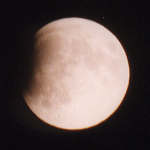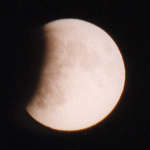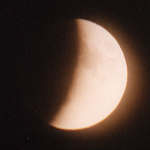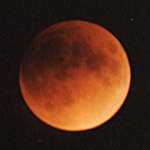|
Total Lunar eclipse January 21, 2000
At 01:30 local we got to our beds and set the alarm clock in between, set to wake us up at 2:30. And that it did. It appeared to us we had only laid to bed when the clock woke us up with the most annoying sound imaginable. It managed only one beep as we jumped from the beds and turned it off. Talk about a rude awakening! We checked the sky through the window and it was now completely clear. Great! We ran down the stairs, got into ZAKJU's car and drove off to Kamnica, Slovenia. The sky was perfectly clear and bright with the moonligh. We drove slowly as there was no hurry... We reached ZAKJU's home at 2:45 and set up the telescope (8'' SCT) and lense (500mm piggyback) on the parking lot. Just then we noticed it was VERY cold...
We noted the first signs of penumbral darkening at around 3:15 local, 12 minutes into the partial penumbral phase. We took our second photo (the first was before the beginning of the penumbral phase). With each minute the Moon's leading limb became darker and darker as it progressed into the penumbra. One interesting effect we noticed was the darkening of crater Plato - it appeared very dark compared to the maria, a very unusual effect.
Taking images in 10 minute intervals, we noticed the umbra at 4:01 right at the predicted beginning of the umbral phase. About 10 minutes later, ATAJU was already confident this was going to be a dark eclipse as the limb covered in umbra was not visible in the 6x30 finder and very hardly visible in the 8'' scope. Unlike the previous two eclipses in 1996 and 1997 that began deep reddish, this one began black! We noticed the surroundings becoming darker with progressing partial umbral stage. We abandoned the LM change monitoring due to light pollution from Maribor.
Around 4:35, more than half an hour into the partial umbral eclipse a huge cloud developed in the northwest and started covering the Moon. We shot some photos through the thin parts of the cloud, but ultimately took a break until 4:58. By then the cloud was almost gone. At 5:05 local, the total umbral eclipse began. The total umbral phase is well summarised in the meteorobs post by ATAJU:
Concerning the Danjon's value of this eclipse.
There has been some contradiction, with some
observers saying the eclipse was dark and some
saying it was very bright. I'd call it something
in between. I've only seen 3 lunar eclipses so
far, including this one (other two are September
1996 and September 1997), and this was the darkest
one. Using the Danjon Scale of Brightness at S&T
website, I'd call it 2.5 - L=2 is described as
'Deep red or rust-colored eclipse with a very dark
central part in the umbra and the outer rim of the
umbra relatively bright'. This description would
fit the early stage of umbral eclipse, somewhere
between the start and mid-eclipse. L=3 is described
as 'Brick-red eclipse usually with a bright or
yellow rim to the umbra'. This would fit the last
stage of the umbral eclipse, with the leading edge
of the Moon being quite bright orange. So I decided
for an L value of 2.5.
I observed all three eclipses with a telescope, and
only several minutes into partial umbral phase it
appeared that the eclipse will be darker than the
previous ones. I recall a very dark red colour of
the leading umbra edge during 1996 eclipse, while
in this one the leading umbra edge appeared dark
grey/black, I had difficulty seeing the moons limb
in the finder and it was very dim in the 8" SCT.
As I already mentioned on the IRC chat, the impression
of a darker eclipse may have come from the fact
that there was a combined 'darkness effect' when the
darkest part of umbra passed over the maria. Compared
to the previous two eclipses, the latest was much
darker, with the September 1996 being 3.0 and
September 1997 3.5.
The total umbral eclipse ended at 6:22 with slender sliver of bright surface at the leading lunar limb. The effect was more and more pronounced as well as the brightening morning sky. We finished by 7:00 as ATAJU had to go to school (although his geography teacher was obviously very fascinated by the eclipse and would've excused him if he hadn't come...).
Next one - Jaunary 19, 2001!!
All photographs and text on this page are © 2000 by MBK Team.
|





